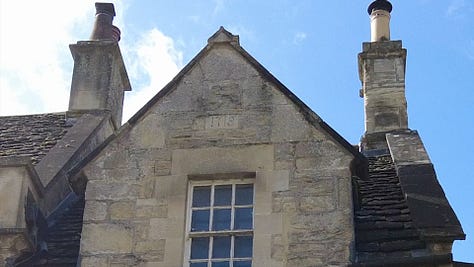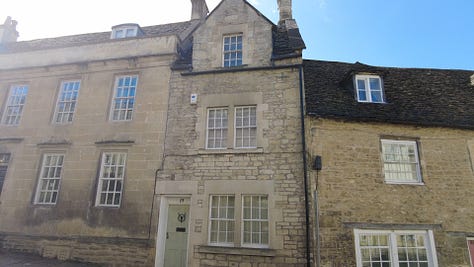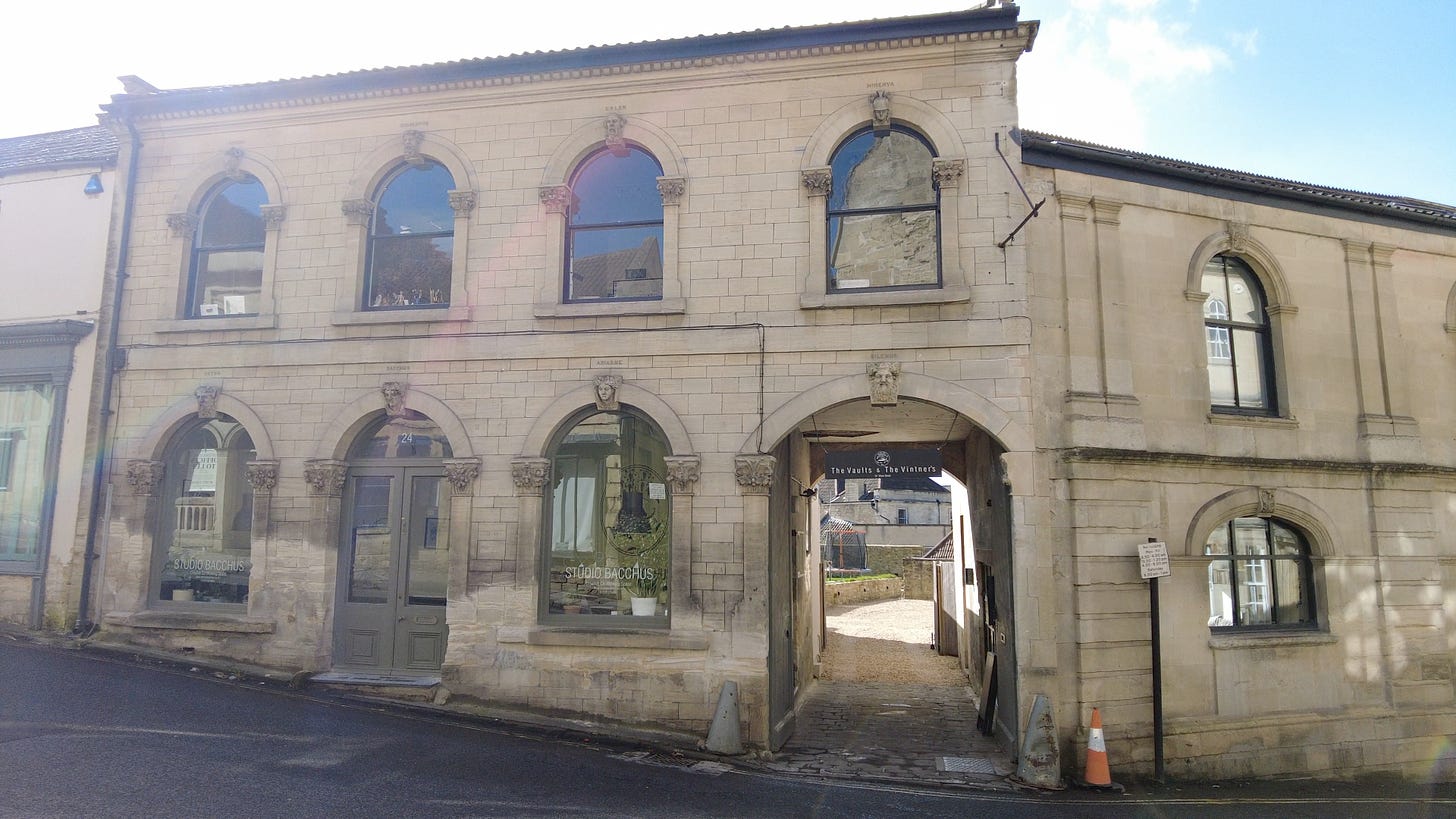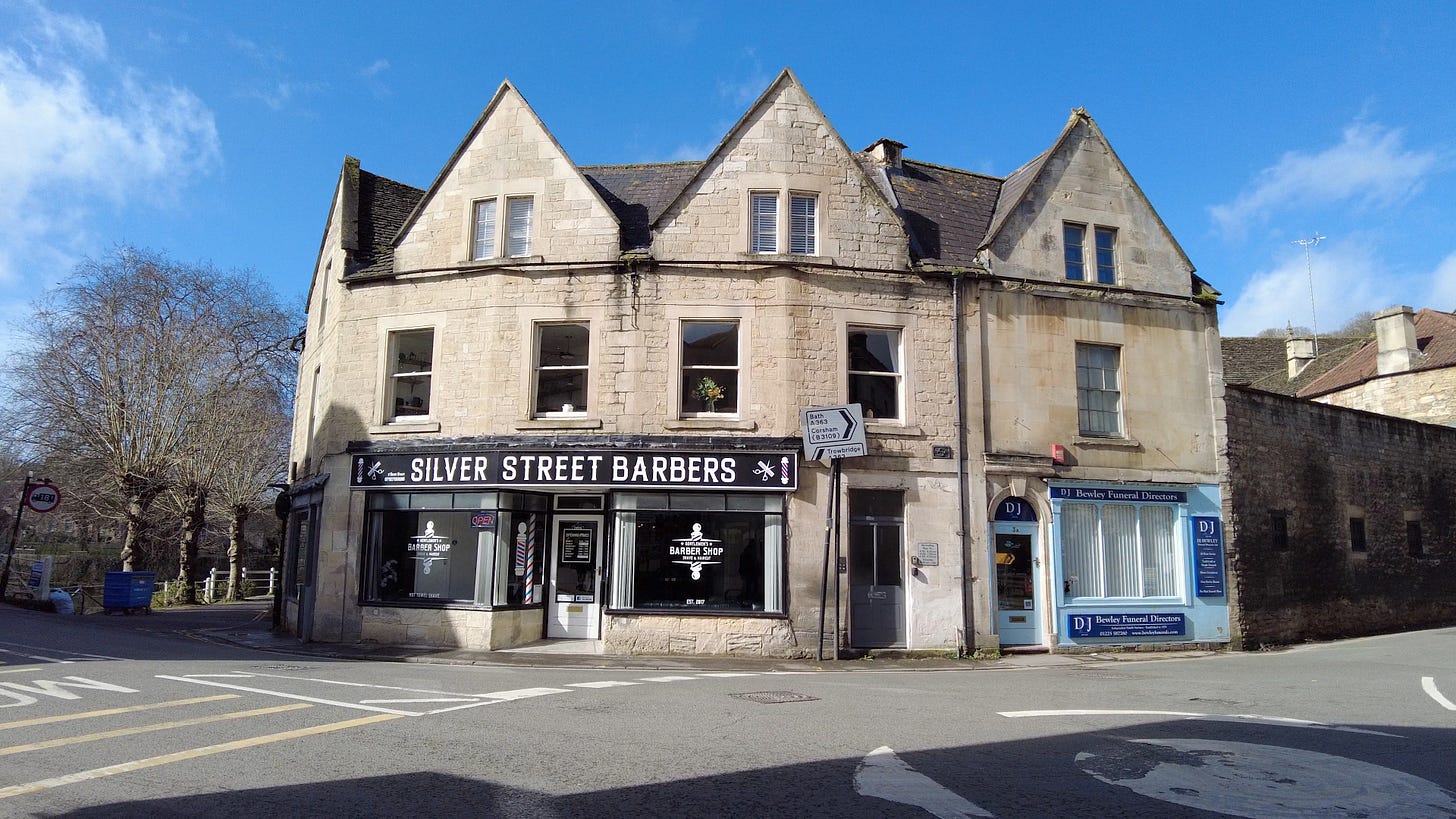Every street creates its history. In this article, we are visiting Silver Street, Bradford on Avon, a charming town in Wiltshire.
Origin of Silver Street
Many towns in the UK have a Silver Street. There has been much debate over this name. We might be tempted to say it has something to do with silver and that the street once had silversmiths. Whilst that might be true in some cases, others raise arguments against that. Back in the late 19th century, James Hurly Pring believed silver is a corruption of the word silva, a wood. He argues that as Britain was covered in forests, the name Silver Street would be common, certainly more common than the number of silversmiths.


The centre of Bradford on Avon is defined by the River Avon and the ancient stone bridge which crosses it.
I start my journey by crossing the Town Bridge as Silver Street begins on the north side of the River Avon, marked by a mini-roundabout. You need to be wary of traffic. Bradford on Avon doesn’t have a by-pass, and the footpaths along the bridge and Silver Street are narrow and, in places, non-existent. Wing mirrors on larger vehicles can overhang the footpaths, so I need to be very careful and not step into the road without looking. It isn’t easy to pass other walkers when it’s busy, and the town can get even busier during the tourist season.
In the above photograph on the right, you can see our first building on Silver Street. (Click the photos to expand) This is the Lamb Building, taking its name from The Lamb Inn, which stood on this site before being demolished to make way for it. The building was constructed in 1916 to extend the Spencer Moulton factory and was later taken over by Avon Rubber. It has been closed since the early 1990s and is now a shopping and restaurant complex. There are plenty of watering holes and feeding stations for visitors and locals alike.
36 and 37 Silver Street
The above photograph looks towards the former Lamb Factory. However, I am interested in the pair of shops by the mini-roundabout. The one farthest away is number 37 Silver Street, and had been occupied by butchers from 1867 to 1988; the last before closing was the Co-operative Butcher.
The shop on the left, number 36, was a drapery shop for much of its life in the 19th century. The whole building might have been the Queen Victoria public house. Where I am standing to take the photograph is known as Knee’s Corner. You can see why by looking at the first photo at the top of the page. Knee’s is still going as a business based in Trowbridge, although now a shadow of its former glory. (More about Knee’s Corner towards the end of this article).
I will continue to show you buildings from this side of the road where these shops are, and we will call it the south side of Silver Street as the road curves up the hill. Once I reach the end of the south side, I will work my way back down on the opposite side of the road and tell you about the buildings and history.


33 and 32 Silver Street
The next property we will next consider is number 33 Silver Street. As in many old towns, the shops are converted houses, and this one is no exception. It was a large early Georgian House. In 1931 it became a Co-operative store and closed in 1988. It was once the home of Francis Hislop, a draper between 1749-1769. In 1791 it became the grocery store of James Budgett (1765-1842). By the end of the 19th century, it had become Edwards’ pork butcher shop and closed in 1931 when the Co-op took possession.
Next door, we have No 32, another Georgian house. It faces the old marketplace and has been a shop since at least the middle of the 19th century. It was once the shop of Keziah Rogers, a fruiterer, greengrocer and seedsman.
Number 31 (see photo below) is, like most properties on this street, a listed building. The large glass windows are quite out of keeping with the style of the street and building. It was built as an extension of J Alex Brown’s business in the late 19th century. Today it is a charity shop and accountants offices. It was once the Cheltenham & Gloucester Building Society.
In the late 1800s, it was a grocers owned by James Gore, who also owned a business across the road at number 11, which I will cover on the way back down.

J Alex Brown, 30 Silver Street, Bradford on Avon
Opened in 1853, J Alex Brown has had several owners in the interim years. It started as an ironmonger, and his son continued the business until 1937. The current owners likewise sell hardware, maintaining a link to the original intention of John Alex Brown. Brown extended the shop in the late 19th century, as mentioned above.


The Christopher Chemist Shop and John S Day Printer
The history of 29 and 28 is interesting. Number 29 is now the office of estate agents Davies and Davies. This was, for many years, a chemist shop, in fact, from 1863 when Thomas Prideaux Saunders established a chemist. It continued trading with different owners until Richard Thorney Christopher took over in 1908 and remained there until he died in 1962. His daughter Angela continued the business until she retired in 1986.
The family had a great interest in history, particularly that of pharmacy. They collected many artefacts, which have been donated to the Bradford on Avon Museum and are now on display in a re-created chemist shop. The museum is on the first floor of the Bradford on Avon Library. For more details about the museum, which is free to visit, click here.
Number 28 is now occupied by Kingstons estate agents. On the day I visited, the property was surrounded by scaffolding, but there is on the front of the building the outline of the sign “Printing Office”. It’s lovely to see these old ghost signs on buildings.
Printers have worked here since the very early part of the nineteenth century. A company named Stump and Bubb were trading in 1822. John Bubb, with the trades, stationer, printer, engraver and jeweller, was trading here under his name from 1832, possibly earlier. He died aged 71 in 1860. In his will, he bequeathed funds for the rebuilding of St Catherine’s Almshouses on Frome Road.
Records show that the next printer to continue in this building was a Mr John Stephen Day, trading as J.S Day. When Day retired, George Farrington continued the business and was known for printing local directories. Farrington remained at number 28 until 1887.
The year 1893 saw a new printer, a man who made this a much larger business. William Charles Dotesio. He was not only a general printer but a bookbinder and maker of business ledgers, something in demand before the age of computers. The business was called Dotesio and Todd. He expanded the business, firstly into larger premises higher up Silver Street. He also had, around the year 1900, a printing works on Frome Road. He then expanded the business into what was then empty woollen mills, Greenland Mills. The business was also trading in Lowestoft in Suffolk. Later it moved to Trowbridge and closed around the 1990s. I can’t find the exact date. There used to be many book printers in Trowbridge and nearby Frome until the production was moved abroad. By the millennium, most had gone out of business.
If you search eBay for old postcards of Bradford on Avon and the area, you may well come across those printed by Dotesio and Todd.



The Old Bear Inn and The Ale & Porter
Continuing my walk up the hill, the next building I wish to write about is The Old Bear Inn (first photo above). A pub has been listed here as far back as 1726. The present frontage you can see in the photograph was rebuilt when Silver Street was widened.
Lying next door we come to The Ale & Porter. Erected in 1884, it was a store for brewers George and Thomas Spencer. Locals often refer to it as The Armoury, as it once served as the Headquarters and armoury of the army volunteer force. It has been used as a storehouse for Avon Rubber. It is currently a beauty salon, having had some prior use as a restaurant.
The Vaults
24 Silver Street is The Vaults. It was built in the early 1880s. It was a shop of the wine merchants Thomas and Emanuel Taylor.



The Narrow House and The Old House
The narrow house is typical of houses built in the medieval period, and the date at the top of the house reads 1718. This is late for this type of house and would have been amongst the last of this style to have been constructed.
The 'The Old House’ is the last on this side of Silver Street. It was briefly The New Inn in the early 18th century, and a Georgian facade was added in the latter part of that century. At one point, a relative of the Taylor’s at The Vaults, Edward Taylor, had a rope, twine and canvas business at The Old House. He also had another part of the business at Rope Walk in Newtown, Bradford on Avon.
Now that I have reached the end of Silver Street, it is time to cross the road and head back down the other side.
The Bunch of Grapes
The ends of Silver Street are not opposite each other. Our first side ends at Mill Lane, and we must head back downhill to Whiteheads Lane. Our first building is The Bunch of Grapes.
In 1762 it was described as "newly built”. How many newly built properties today will last this long? It was the shop of a chemist, William Harris; then it became a wine merchant shop owned by the Taylor’s of The Vaults across the road. It was already known as The Bunch of Grapes in 1846 when the Taylor’s purchased it. It remained a wine merchant until the 1930s, when it became a public house and retained the name.
Silver Street House
Silver Street House has an eighteenth-century facade, but its origins go much further back in time. The core of the building dates back to the sixteenth century. Silver Street House was once the Angel Inn, then The New Bear Hotel. The hotel closed in 1958 and was in need of rescue. Its salvation came in 1974 when the Bradford on Avon Preservation Trust purchased it and converted it into the six flats which are occupied today.



Three in a row! 11, 10 and 9 Silver Street
11 Silver Street is a Georgian building. It has Victorian sash windows on the ground floor. Interestingly the right-hand side of the building dates from the fifteenth century, and this has a medieval timber roof. Originally it would have been two houses from the medieval period. Please click any photo to enlarge them.
In 1841 it was owned by the brewers, George, Thomas and John Spencer. They ran a brewery behind Silver Street House when it was The New Bear Hotel. For a long time, it was a grocer, baker and dairy shop. A quick review of this shop's use: In 1871, it was operated by James Gore, a baker. By 1903 records show the shop owned by James Stevens. In 1911 the name was changed to The Silver Street Dairy.
1915 saw the arrival of Ernest Williams, and his tenure continued until someone called A. Seviour in the 1930s ran the business. During the 1950s and 60s, an M.H. Thomas took over the running of The Silver Street Dairy. The name was changed in the 1970s to The Dairy and, until the 1980s, was under the care of Bill and Frances Taylor. This building has a very long history of providing for the needs of the people of Bradford on Avon.
10 Silver Street is Canterbury House, so named because it was the shop of a butcher selling New Zealand lamb. Opened in 1830, it remained a butcher shop until recent times. It is now Dream Doors.
9 Silver Street (now Wealth Management) includes a very narrow building and was previously Pike’s butcher shop. It became an ice cream parlour that operated with The Olde Sweet Shoppe next door (opened in 2010); both have now closed. The narrow building was once Ernie Sadd’s barber shop. We have seen a number of these houses on Silver Street, and they would have been common in the early days of the town’s history.


8 and 7 Silver Street
8 Silver Street - was once part of the drapery shop of William Rogers and then of J.F. Goodall until that closed, and in the 1980s, it was M. & G. Phillis, selling men’s and boys’ clothes.
7 Silver Street This building has a long history in drapery and clothing. In 1822 records show John Alford, a linen draper, was operating here. It was bought in 1876 by a silk mercer and undertaker, William Rogers. That’s quite a combination of occupations! At some point during the 1890s, John F Goodall purchased it and established his business, which included number 8 next door
6 Silver Steet
6 Silver Street is a rare red-brick building for Bradford on Avon, a town where most of the older properties use local stone. This, though, age-wise, is a newer building for the town constructed towards the end of the nineteenth century. As you can tell from the photo it was originally built as a row of shops. This was for Harding’s Brewery Shop, and the brewery was behind it.
In 1936, T.W. Coupland’s Grocery (International Stores) took over the building, and although they have gone it’s good to see businesses still using it today.


The King’s Arms
The former King’s Arms lies on the corner of Coppice Hill, with The Shambles to the left in the photograph. The building includes the remains of a 17th-century house. It was the centre of Bradford on Avon’s Market Place and faced the old Town Hall. Market days must have been very good for business. It is now a shop but has been a pub until more recent times.
It has been called the King’s Arms since 1809, and for a while, in the 1990s, it had one of those trendy names when it became a gastro-pub, The Sprat & Carrot. This was followed by King’s Spice when it was an Indian restaurant. Prior to 1809, it was known as, The George, The Boot and the New White Hart.


Knee’s Corner
As mentioned earlier, this area of Bradford on Avon by the mini-roundabout connecting Silver Street with the junction of Market Street has been nicknamed Knee’s Corner. Some of the former Knee’s Store was demolished to give motorists a better view when emerging from Market Street into Silver Street. You can see the result by comparing the two photos above.
Ward’s Corner
Numbers 1-3, opposite Knee’s Corner, are likewise named after a former business. It is named after the newsagent and stationer Atkinson Ward, which occupied number 1, close to the river. His wife, Elizabeth Rebecca Ward, was a writer and used the pseudonym Fay Inchfawn. Number 2 was the shoe shop of Mark Uncles before his son Rowland moved it into Market Street.
I hope you have enjoyed this tour of Silver Street, Bradford on Avon. There will be more "One Street at a Time” articles to come. If you’re not a subscriber, please add your email address so that you don’t miss any future articles.
Please feel free to leave a comment; it’s always good to hear from my subscribers. You can join the chat on the app or on the website here.














Fascinating read about buildings I recognise but know so little about the history.